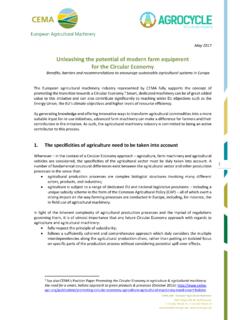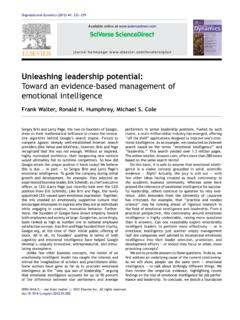Transcription of Unleashing the Potential of Maritime Innovation Networks
1 Unleashing the Potential of Maritime Innovation NetworksZoran Perunovic , Mads Christoffersen, and Sofia F rstenbergMade possible by a grant from the Danish Maritime FoundationIn collaboration withThis report analyzes collaboration within the Maritime industry for Innovation , deter-mines the key enablers, barriers, and mechanisms of Maritime Innovation Networks , identifies the key characteristics of collaborative Innovation processes applied in the Maritime industry, and suggests necessary managerial actions for organized and suc-cessful Innovation in Networks . The authors ambition is to establish common knowl-edge and understanding across the industry concerning network Innovation dynamics and provide the context within which Maritime organizations can assess the benefits and risks of their participation in different types of Innovation AuthorsZoran Perunovic Zoran Perunovic is an Associate Professor and Academic Director of DTU s Executive MBA program.
2 He has more than 20 years of experience in consulting companies, organizations, and governments in Europe, North America, Asia, and Africa. Zoran has been developing execu-tive programs and teaching Innovation , entrepreneurship, consultancy methods, strategy, and operations at executive, graduate, and undergraduates levels at several European and American universities. His research interest is in Innovation leadership and design and application of inno-vation models and procedures in established companies, organizations, and start-ups. Mads ChristoffersenMads Christoffersen is an Associate Professor Emeritus and a former Director of DTU s Execu-tive MBA program.
3 Mads has been engaged in research related to applications of information and communication technologies for two decades, first at DTU, and then in the industry. He held various managerial positions at TDC, within R&D and new business creation, and France T l com in Paris. Mads was a visiting professor at University of Strathclyde, Glasgow, Program Manager for Telekom Malaysia s Senior Management Development Program. Areas of his latest research include Innovation , international business development and F rstenbergSofia F rstenberg, Innovation Portfolio Manager in Maersk Maritime Technology and with EMBA in Shipping & Logistics, has been solving technology challenges for the Maritime industry since 2006, when she started her Maritime career as an environmental advisor to the industry.
4 With her broad Maritime network and thorough insight to the business of shipping and its related challenges in the current market, not least regarding Innovation , she has provided Maritime context and content, access to key resources of information, as well as being a critical reader and discussion partner throughout this by DTU Business, Kgs. Lyngby 2015 The report is based on analyses from the research project Innovation in Networks , supported by a grant from the Danish Maritime Foundation (project number 2012-121). Table of ContentsWhy innovate in Networks ? ..4 Method.
5 4 The context for Maritime Innovation ..5 Which Networks are used for Maritime innovations? ..6 Centralized ..7 Triad ..8 Publicly funded ..9 Horizontal .. 10 Experts forum .. 11 Informal .. 12 How is Maritime industry using Innovation Networks ? .. 13 Response to uncertainties .. 14 Networks and Innovation funnel .. 14 Choice of partners .. 15 Structural holes .. 15 Stakeholders presence in Innovation Networks .. 16 Unleashing the Potential of Maritime Innovation Networks .
6 17 Which Innovation network to use? .. 18 Using Networks to create standards and influence regulations .. 19 Enhanced holistic and life-cycle approaches .. 19 A new measurement system for capturing value .. 19 Improving novelty from a routine to breakthrough or disruptive Innovation .. 20 Innovation network management system .. 21 PAGE 4 Unleashing THE Potential OF Maritime Innovation Networks | DTU BUSINESSWhy innovate in Networks ? Maritime organizations have innovated in the past by alternating between linear technology push and market pull models, well suited to the opportunities and challenges of former market environments.
7 Today, technological, market, and regula-tory challenges are creating a specific complex context for contemporary Maritime organizations and their innovative efforts. Single organization rarely has all necessary competences and capabilities to deal with multiple challenges and uncertainties. Therefore, the industry is expected to form Networks of organizations and collaborate for of Innovation models in the Maritime industry1 Maritime stakeholders should be prepared to apply the basic principles of network Innovation . Recognizing this trend and institutionalizing Innovation processes could be essential to achieving and sustaining competitive data have been collected over an 18 month period from multiple sources: interviews with more than 100 key inform-ants from 40 Maritime organizations, analysis of numerous internal company materials, industry reports, publicly available reports on over 30 Innovation Networks , newspaper and magazine article, and an extensive literature review of more than 50 academic journal Adopted from Perunovic Z.
8 , Vidic -Perunovic J., (2012). Environmental Regulation and Innovation Dynamics in the Oil Tanker Industry , California Management Review, 55, 1, pp. 130-148 Market PullMarket PullTechnologyPushCoupledModelIntegrated ModelINNOVATIONIN NETWORKSINNOVATION(GENERATION & EI)TIME (YEAR)187819791990 Models(generations) ofInnovationEnvironmentalInnovation2016 IIIIIIIIVIVDISASTERSPUBLIC PRESSUREPUBLIC PRESSUREIMPERFECTPRESCRIPTIVE POLICYTECHNICAL CHALLENGESTECHNICAL CHALLENGESGOAL BASED POLICYIMPERFECTPRESCRIPTIVE POLICYDISASTERSDTU BUSINESS | Unleashing THE Potential OF Maritime Innovation Networks PAGE 5 The context for Maritime innovationMost practitioners agree that the major drivers for Innovation in the contemporary Maritime industry are environmental regulations.
9 However, participants in the Maritime industry still operate in volatile markets where competition is fierce, costs are high, and margins are decreasing. The context for Maritime innovations is influenced by the interaction of three major groups of challenges:THE MARKET1. Discrepancy between the dynamics of global trade and the shipbuilding industry are reflected in new vessel ordering times, yard capacity, and the cost of new construction. During the recession, the result was surplus vessel capacity and a lack of incentive for industry Innovation . 2. Trade specialization of ships.
10 Dispersed global manufacturing and trade route movability could lead to surplus capac-ity or obsolete vessel types undermining ship owners /operators earning Potential , decreasing the new vessel orders and, ultimately, reducing willingness to innovate. 3. Unpredictable fuel prices could influence intensity to which companies innovate to reduce CO2 because the major incentives for operators are to reduce fuel cost and increase performance. 4. The competitive efficiency of existing fleets in terms of future performance requirements and compliance with future regulatory requirements focus Innovation efforts on either retrofit solutions or new Uncertain enforcement dates.









